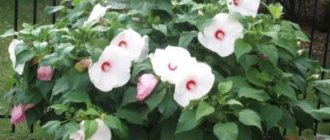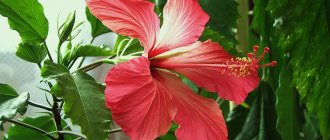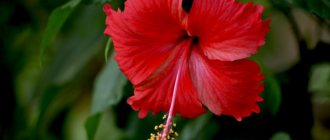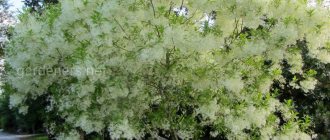For the extraordinary beauty and characteristic shape of the buds, the delicate hibiscus was nicknamed the “Chinese rose.” The flower is surrounded by so many legends and mystical mysteries that some are still superstitiously afraid to keep it at home. However, there are no objective reasons to refuse the desired flowerpot. We’ll tell you in this article how to grow a Chinese rose healthy and spectacular!
general information
Chinese is one of the most beautiful ornamental plants with large flowers, from which they even weave wreaths for newlyweds in India. The mysterious flower is so popular that in many regions it appears among the national symbols: from Malaysia to the Hawaiian Islands. It came to us from Asia and the Pacific Islands. The leaves of the Chinese rose resemble those of birch - the same dark, smooth and slightly jagged. But it is the flowers that are noteworthy - large narrow bowls, widely opening with petals up to 25 cm in diameter. The most common varieties are red, but there are pink, white, yellow and multi-colored varieties.
Types of Chinese roses
There are hundreds of species of hibiscus in nature, but it is the Chinese varieties that have taken root in our latitudes. That is why we can safely say that the Chinese rose and hibiscus are one and the same, because we have almost no others.
Syrian rose
Syrian hibiscus is quite resistant to cold, which is why it is most often found in our gardens. In the southern regions, it requires practically no maintenance at all - just forming a crown.

Maple Leaf Mahogany
A rare variety of Chinese rose, which is also grown for its decorative foliage. Its plates are large, reddish, with the same burgundy or red flowers. In Asian countries, its sour leaves are used as a vegetable.

Sudanese rose
The Indian hibiscus bush is the same hibiscus that we know as flower tea. The variety is most often planted as a food variety, and it does not tolerate frost at all.

Northern Rose
Northern hibiscus with whitish flowers is also called trifoliate for the shape of its three-lobed leaves. It is less noticeable, but it is completely unpretentious and is known for its healing properties.
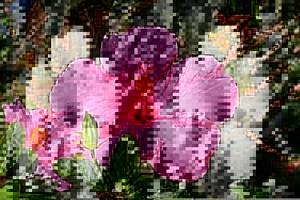
Hybrid hibiscus
This is a large category that includes many varieties crossed from three different types of hibiscus. In our latitudes, this choice is very universal, because the hybrids are frost-resistant and colorful, with flowers up to 25 cm.
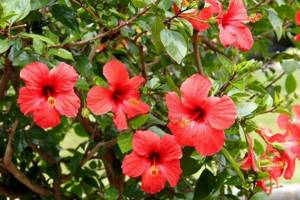
Angel wings
This is a very compact greenhouse variety that grows up to only 30 cm. The small bush is densely covered with white flowers with a pink center - and their number reaches up to a hundred.

Indoor Chinese rose
In fact, this is another large category of decorative hybrids with flowers of various shapes and colors. For example, the fancy curved Schizopetalus, the delicate white Mix, the variegated Cooper's hibiscus or the bright yellow King.

Varieties of garden hibiscus
There are about 500 varieties and types of hibiscus. Only three types are considered the most popular:
- Syrian hibiscus is loved by gardeners for its rich, variegated colors. It grows slowly and lives up to a hundred years on clay soil. Frost-resistant. Popular varieties include double purple ' Ardens ' and pink-and-white ' Lady Stanley ', simple blue-violet ' Blue Bird ' and deep crimson or purple ' Woodbridge '.
- Hybrid hibiscus has large inflorescences. This heat-loving species is perennial. The most popular varieties are: “ Albus ” with white flowers, “Diana” with wavy edges, hot pink “ RussianViolet ” and terry, violet-blue with a spot of red “ Violet Elar Double ”. Domestic breeders bred “Collective Farmer”, “Michurinets” and “Snezhinka”.
- Chinese hibiscus or otherwise “Chinese rose” is valued for its unpretentiousness. This plant is an evergreen with feather-like leaves. It mainly grows in indoor environments, but also appears in gardens as a voluminous, lush bush, if the climate permits. There are varieties such as simple red “ Alicante ”, pink semi-double “ Rosa ”, rich pink and red “ Flamingo ”, yellow double “ Koenig ”.
Popular varieties of hibiscus are shown in the photo:
Chinese rose care
Chinese rose can be safely grown in the garden and apartment. At home it is an evergreen shrub, and outside it is a large tree up to 3 m tall. Hibiscus feels best in a greenhouse because it does not tolerate frosty winters.
Temperature
The Chinese rose prefers a temperature of 18-25 degrees, so in summer it does well on the balcony and in the garden. In winter, the thermometer in the room should not fall below 15 degrees, because already at 10 it will shed its leaves.

Lighting
The Chinese rose definitely needs more light, because otherwise it simply will not bloom. But direct rays are also destructive, so shade the tree. In summer, feel free to take the flowerpot out onto the balcony or terrace, but do not leave it in a draft.
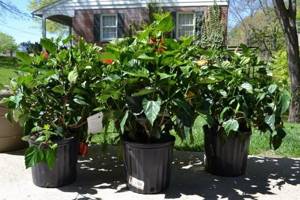
Watering
There is no standard watering schedule because you need to monitor the condition of the soil. Until you get used to distinguishing visually, check the substrate with a wooden stick to a depth of 2-3 cm. Do not use cold water or tap water, because it should at least sit for a couple of days.
Chinese rose loves high humidity - which means humidifiers and spraying from a spray bottle. Give her a warm shower periodically to wash away dust and dirt from large leaves. Make sure that water does not get on the buds, otherwise marks will remain on them and they will fly off faster.
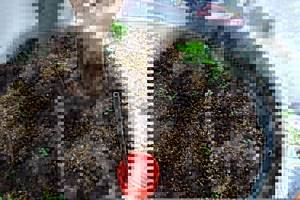
The soil
You need soil for flowering plants with turf and sand, and, if necessary, peat for young seedlings. Place a thick layer of drainage at the bottom. For adult hibiscus, instead of replanting, it is enough to annually update 2-3 cm of the top layer of soil.

Fertilizers and fertilizing
From mid-spring to mid-autumn, fertilize the Chinese rose twice a month. It responds well to organic matter, but we recommend alternating with mineral mixtures. In winter, feed the bush only if it blooms - spot on, with a quarter of the dose of potassium and phosphorus.

Transplantation and propagation
A young Chinese rose is replanted every year because it grows and develops rapidly. After five years, adult plants are relocated as the soil becomes depleted or the pot needs to be replaced. Usually this is no more than once every three to four years. But the flowerpot should be slightly cramped, otherwise the bush will grow greenery instead of flowering.
Chinese rose is almost never propagated by seeds because it takes a long time. Although the process is quite simple, because it has a surprisingly high germination rate, which lasts for six years. The seeds are germinated in damp gauze and in a plastic bag with holes, and after a week or two the seedlings are planted in cups with peat and ash.
Shoots that remain after seasonal pruning are suitable for cuttings. Treat the sections with an antiseptic and a stimulant, and then place them in a glass of water or stick them in cups with sand and peat. Within a month, roots will appear, and the Chinese rose can be planted.
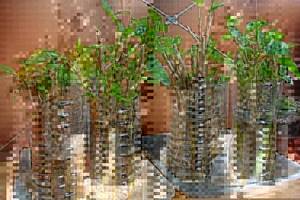
Trimming
At the beginning of spring, be sure to carry out sanitary pruning - this way the Chinese rose will bloom faster and earlier. If you reduce the amount of green mass, more flowering shoots will appear. In general, you can shorten the bush by about half, and for rejuvenation - up to 15 cm.
With the help of shaping pruning, you can turn a Chinese rose into a neat standard tree. And if you want a lush, dense shrub, periodically pinch and thin out the branches that go deep.

Planting garden hibiscus
Selecting a location
The planting site should be light or semi-shaded. Although hibiscus tolerates frosts down to -25 degrees, it is still thermophilic. For cool climates, there are special hardy varieties, often non-double.
Timing
Garden hibiscus is planted in the spring. The young plant needs to be protected from the wind, and at first from frost.
Preparing mail
The ideal soil composition for hibiscus is 5 percent perlite, 45 percent hardwood bark and 50 percent peat. It should contain a sufficient amount of organic matter and be slightly acidic, for which it is recommended to keep the pH level within the range of 5.5 to 6.5.
For more information about planting and caring for hibiscus, watch the video:
Features of landing
First, you need to dig a planting hole slightly wider and deeper than the container from which the hibiscus is transplanted.
Be sure to check the drainage. To do this, pour a gallon of water into the planting hole. If it disappears within an hour, then the pit is ready to accept a new green guest. At the same time, the soil must absorb moisture well, otherwise the hibiscus will die from drought. Ideally, in the same hour, water from the surface of the earth penetrates into it to a depth of 30 centimeters.
If the hole and the soil as a whole have passed the test, you can begin planting. After watering the hole, seedlings are placed into it. The colder the climate, the deeper the hole should be. If the climate is warm, it is recommended to leave the upper part of the plant roots above the ground.
If we are talking about planting seeds , then they need to be placed in a tray filled with damp organic fertilizer, at a distance of half a centimeter from each other.
They are sprinkled with soil on top and watered. They need warmth and sunlight to germinate. The result will be in three weeks. When the hole with the plant is filled with soil, it needs to be watered two or three times.
To choose climbing plants for your garden, read the article.
Read about ornamental shrubs for the garden here -
Pest and disease control
Hibiscus leaves suffer from chlorosis and vascular wilt - and most often this is a consequence of improper care. It is necessary to adjust the watering regime, arrange good drainage and apply fertilizers on time. Trim the affected areas as quickly as possible to prevent the disease from spreading, and treat the plant with fungicides.
Aphids, scale insects and spider mites live among the flowers of the Chinese rose. Gall midges hide in the buds, and whiteflies and scale insects eat the leaves. Remove fallen buds in a timely manner, seasonally spray with insecticides, use soap solution and tobacco dust.

Reproduction
Garden hibiscus propagates by seeds, cuttings and division.
seeds are found in pods that form within the flowers. After ripening, the pods open and the seeds fall to the ground, where they easily germinate on their own. For planting in a new location, the seeds are collected when the pods turn brown.
cuttings are carried out in June or October. To do this, the pagon is cut obliquely from the top of the bush with pruning shears. The lower leaves are removed. Before planting, the pagon is placed in water. A hole is made in a pot of soil and filled with half a teaspoon of growth accelerator powder.
The cuttings are placed at a distance of five centimeters from the surface of the earth, covered tightly with soil and watered. Using film and a frame, a small greenhouse is created around it.
Germination requires heat and light, but not direct sunlight.
For propagation, the hibiscus bush can be divided . The rhizome is torn by hand or cut with pruners. This should be done exclusively in the spring. After planting, the plants need to be fertilized and watered.
Chinese rose – photo
Breeders waste no time, and varieties of Chinese roses are very diverse. But all of them are undeniably beautiful and impressive - this is clearly visible in our photo selection!
